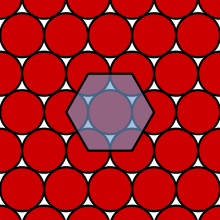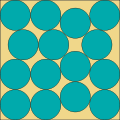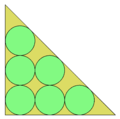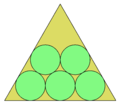- Packing problem
-
Part of a series on Puzzles  Types
Types- Guessing game
- Logic puzzle
- Dissection puzzle
- Induction puzzle
- Logic grid puzzle
- Self-reference puzzle
- Mechanical puzzle
- Puzzle video game
- Transport puzzle
- Word puzzle
- Metapuzzle
TopicsPacking problems are a class of optimization problems in mathematics which involve attempting to pack objects together (often inside a container), as densely as possible. Many of these problems can be related to real life packaging, storage and transportation issues. Each packing problem has a dual covering problem, which asks how many of the same objects are required to completely cover every region of the container, where objects are allowed to overlap.
In a packing problem, you are given:
- 'containers' (usually a single two- or three-dimensional convex region, or an infinite space)
- 'goods' (usually a single type of shape), some or all of which must be packed into this container
Usually the packing must be without overlaps between goods and other goods or the container walls. The aim is to find the configuration with the maximal density. In some variants the overlapping (of goods with each other and/or with the boundary of the container) is allowed but should be minimized.
Covering-packing dualities Covering problems Packing problems Minimum set cover Maximum set packing Minimum vertex cover Maximum matching Minimum edge cover Maximum independent set Contents
Packing infinite space
Many of these problems, when the container size is increased in all directions, become equivalent to the problem of packing objects as densely as possible in infinite Euclidean space. This problem is relevant to a number of scientific disciplines, and has received significant attention. The Kepler conjecture postulated an optimal solution for packing spheres hundreds of years before it was proven correct by Thomas Callister Hales. Many other shapes have received attention, including ellipsoids[1], Platonic and Archimedean solids[2] including tetrahedra[3][4], and unequal-sphere dimers[5].
Hexagonal packing of circles
These problems are mathematically distinct from the ideas in the circle packing theorem. The related circle packing problem deals with packing circles, possibly of different sizes, on a surface, for instance the plane or a sphere.
The counterparts of a circle in other dimensions can never be packed with complete efficiency in dimensions larger than one (in a one dimensional universe, the circle analogue is just two points). That is, there will always be unused space if you are only packing circles. The most efficient way of packing circles, hexagonal packing, produces approximately 91% efficiency.[1]
Sphere packings in higher dimensions
In three dimensions, the face-centered cubic lattice offers the best lattice packing of spheres, and is believed to be the optimal of all packings. The 8-dimensional E8 lattice and 24-dimensional Leech lattice are also believed to be optimal.
Packings of Platonic solids in three dimensions
Cubes can easily be arranged to fill three-dimensional space completely, the most natural packing being the cubic honeycomb. No other Platonic solid can tile space on its own, but some preliminary results are known. Tetrahedra can achieve a packing of at least 85%. One of the best packings of regular dodecahedra is based on the aforementioned face-centered cubic (FCC) lattice.
Tetrahedra and octahedra together can fill all of space in an arrangement known as the tetrahedral-octahedral honeycomb.
Solid Maximum known packing density Lowest upper bound for lattice packing density icosahedra 0.836315[6] 0.836357[7] dodecahedra 0.904002[6] (5+sqrt(5))/8=0.904508[7] octahedra 0.947003[6] 18/19 = 0.947368[8] Packing in 3-dimensional containers
Spheres into a Euclidean ball
The problem of finding the smallest ball such that k disjoint open unit balls may be packed inside it has a simple and complete answer in n-dimensional Euclidean space if
 , and in an infinite dimensional Hilbert space with no restrictions. It is worth describing in detail here, to give a flavor of the general problem. In this case, a configuration of k pairwise tangent unit balls is available. Place the centers at the vertices a1,..,ak of a regular
, and in an infinite dimensional Hilbert space with no restrictions. It is worth describing in detail here, to give a flavor of the general problem. In this case, a configuration of k pairwise tangent unit balls is available. Place the centers at the vertices a1,..,ak of a regular  dimensional simplex with edge 2; this is easily realized starting from an orthonormal basis. A small computation shows that the distance of each vertex from the barycenter is
dimensional simplex with edge 2; this is easily realized starting from an orthonormal basis. A small computation shows that the distance of each vertex from the barycenter is  . Moreover, any other point of the space necessarily has a larger distance from at least one of the
. Moreover, any other point of the space necessarily has a larger distance from at least one of the  vertices. In terms of inclusions of balls, the
vertices. In terms of inclusions of balls, the  open unit balls centered at
open unit balls centered at  are included in a ball of radius
are included in a ball of radius  , which is minimal for this configuration.
, which is minimal for this configuration.To show that this configuration is optimal, let
 be the centers of
be the centers of  disjoint open unit balls contained in a ball of radius
disjoint open unit balls contained in a ball of radius  centered at a point
centered at a point  . Consider the map from the finite set
. Consider the map from the finite set  into
into  taking
taking  in the corresponding
in the corresponding  for each
for each  . Since for all
. Since for all  ,
,  this map is 1-Lipschitz and by the Kirszbraun theorem it extends to a 1-Lipschitz map that is globally defined; in particular, there exists a point
this map is 1-Lipschitz and by the Kirszbraun theorem it extends to a 1-Lipschitz map that is globally defined; in particular, there exists a point  such that for all
such that for all  one has
one has  , so that also
, so that also  . This shows that there are
. This shows that there are  disjoint unit open balls in a ball of radius
disjoint unit open balls in a ball of radius  if and only if
if and only if  . Notice that in an infinite dimensional Hilbert space this implies that there are infinitely many disjoint open unit balls inside a ball of radius
. Notice that in an infinite dimensional Hilbert space this implies that there are infinitely many disjoint open unit balls inside a ball of radius  if and only if
if and only if  . For instance, the unit balls centered at
. For instance, the unit balls centered at  , where
, where  is an orthonormal basis, are disjoint and included in a ball of radius
is an orthonormal basis, are disjoint and included in a ball of radius  centered at the origin. Moreover, for
centered at the origin. Moreover, for  , the maximum number of disjoint open unit balls inside a ball of radius r is
, the maximum number of disjoint open unit balls inside a ball of radius r is  .
.Spheres in a cuboid
Determine the number of spherical objects of given diameter d can be packed into a cuboid of size a × b × c.
Packing in 2-dimensional containers
Packing circles
Circles in circle
Pack n unit circles into the smallest possible circle. This is closely related to spreading points in a unit circle with the objective of finding the greatest minimal separation, dn, between points.
Optimal solutions have been proven for n≤13, and n=19.
Circles in square
Pack n unit circles into the smallest possible square. This is closely related to spreading points in a unit square with the objective of finding the greatest minimal separation, dn, between points.[9] To convert between these two formulations of the problem, the square side for unit circles will be L=2+2/dn.
Optimal solutions have been proven for n≤30.[10]
Circles in isosceles right triangle
Pack n unit circles into the smallest possible isosceles right triangle. Good estimates are known for n<300.[11]
Circles in equilateral triangle
Pack n unit circles into the smallest possible equilateral triangle. Optimal solutions are known for n<13, and conjectures are avaiable for n<28.[12]
Packing squares
Squares in square
Main article: Square packing in a squarePack n unit squares into the smallest possible square.
Optimal solutions have been proven for n=1-10, 14-16, 23-25, 34-36, 62-64, 79-81, 98-100, and any square integer.[13]
The wasted space is asymptotically o(a7/11).[14]
Squares in circle
Pack n squares in the smallest possible circle.
Minimum solutions:[citation needed]
Number of squares Circle radius 1 0.707... 2 1.118... 3 1.288... 4 1.414... 5 1.581... 6 1.688... 7 1.802... 8 1.978... 9 2.077... 10 2.121... 11 2.215... 12 2.236... Packing rectangles
Identical rectangles in a rectangle
The problem of packing multiple instances of a single rectangle of size (l,w), allowing for 90o rotation, in a bigger rectangle of size (L,W) has some applications such as loading of boxes on pallets and, specifically, woodpulp stowage.
For example, it is possible to pack 147 rectangles of size (137,95) in a rectangle of size (1600,1230).[15]
Different rectangles in a rectangle
The problem of packing multiple rectangles of varying widths and heights in an enclosing rectangle of minimum area (but with no boundaries on the enclosing rectangle's width or height) has an important application in combining images into a single larger image. A web page that loads a single larger image often renders faster in the browser than the same page loading multiple small images, due to the overhead involved in requesting each image from the web server.
An example of a fast algorithm that packs rectangles of varying widths and heights into an enclosing rectangle of minimum area is here.
Related fields
In tiling or tesselation problems, there are to be no gaps, nor overlaps. Many of the puzzles of this type involve packing rectangles or polyominoes into a larger rectangle or other square-like shape.
There are significant theorems on tiling rectangles (and cuboids) in rectangles (cuboids) with no gaps or overlaps:
- Klarner's theorem: An a × b rectangle can be packed with 1 × n strips iff n | a or n | b.[16]
- de Bruijn's theorem: A box can be packed with a harmonic brick a × a b × a b c if the box has dimensions a p × a b q × a b c r for some natural numbers p, q, r (i.e., the box is a multiple of the brick.)
The study of polyomino tilings largely concerns two classes of problems: to tile a rectangle with congruent tiles, and to pack one of each n-omino into a rectangle.
A classic puzzle of the second kind is to arrange all twelve pentominoes into rectangles sized 3×20, 4×15, 5×12 or 6×10.
Packing of irregular objects
Packing of irregular objects is a problem not lending itself well to closed form solutions; however, the applicability to practical environmental science is quite important. For example, irregularly shaped soil particles pack differently as the sizes and shapes vary, leading to important outcomes for plant species to adapt root formations and to allow water movement in the soil.[17]
See also
- Set packing
- Bin packing problem
- Slothouber-Graatsma puzzle
- Conway puzzle
- Tetris
- Covering problem
- Knapsack problem
- Tetrahedron packing
- Cutting stock problem
- Kissing number problem
Notes
- ^ Donev, A.; Stillinger, F.; Chaikin, P.; Torquato, S. (2004). "Unusually Dense Crystal Packings of Ellipsoids". Physical Review Letters 92 (25). doi:10.1103/PhysRevLett.92.255506.
- ^ Torquato, S.; Jiao, Y. (Aug 2009). "Dense packings of the Platonic and Archimedean solids". Nature 460 (7257): 876–879. Bibcode 2009Natur.460..876T. doi:10.1038/nature08239. ISSN 0028-0836. PMID 19675649.
- ^ Haji-Akbari, A.; Engel, M.; Keys, A. S.; Zheng, X.; Petschek, R. G.; Palffy-Muhoray, P.; Glotzer, S. C. (2009). "Disordered, quasicrystalline and crystalline phases of densely packed tetrahedra". Nature 462 (7274): 773–777. Bibcode 2009Natur.462..773H. doi:10.1038/nature08641. PMID 20010683.
- ^ Chen, E. R.; Engel, M.; Glotzer, S. C. (2010). "Dense Crystalline Dimer Packings of Regular Tetrahedra". Discrete & Computational Geometry 44 (2): 253. doi:10.1007/s00454-010-9273-0.
- ^ Hudson, T. S.; Harrowell, P. (2011). "Structural searches using isopointal sets as generators: Densest packings for binary hard sphere mixtures". Journal of Physics: Condensed Matter 23 (19): 194103. doi:10.1088/0953-8984/23/19/194103.
- ^ a b c Torquato, S.; Jiao, Y. (Aug 2009). "Dense packings of the Platonic and Archimedean solids". Nature 460 (7257): 876–879. Bibcode 2009Natur.460..876T. doi:10.1038/nature08239. ISSN 0028-0836. PMID 19675649.
- ^ a b Betke, U. & Henk, M. Densest lattice packings of 3-polytopes. Comput. Geom. 16, 157–186 (2000)
- ^ Minkowski, H. Dichteste gitterfo¨rmige Lagerung kongruenter Ko¨rper. Nachr. Akad. Wiss. Go¨ttingen Math. Phys. KI. II 311–355 (1904).
- ^ Croft, Hallard T.; Falconer, Kenneth J.; Guy, Richard K. (1991). Unsolved Problems in Geometry. New York: Springer-Verlag. pp. 108–110. ISBN 0-387-97506-3.
- ^ Eckard Specht (20 May 2010). "The best known packings of equal circles in a square". http://hydra.nat.uni-magdeburg.de/packing/csq/csq.html. Retrieved 25 May 2010.
- ^ Specht, Eckard (2011-03-11). "The best known packings of equal circles in an isosceles right triangle". http://hydra.nat.uni-magdeburg.de/packing/crt/crt.html. Retrieved 2011-05-01.
- ^ Melissen, J. (1995). "Packing 16, 17 or 18 circles in an equilateral triangle". Discrete Mathematics 145: 333–342. doi:10.1016/0012-365X(95)90139-C.
- ^ Erich Friedman, "Packing unit squares in squares: a survey and new results", The Electronic Journal of Combinatorics DS7 (2005).
- ^ P. Erdős and R. L. Graham, "On packing squares with equal squares", Journal of Combinatorial Theory, Series A 19 (1975), pp. 119–123.
- ^ E G Birgin, R D Lobato, R Morabito, "An effective recursive partitioning approach for the packing of identical rectangles in a rectangle", Journal of the Operational Research Society, 2010, 61, pp. 306-320.
- ^ Wagon, Stan (August–September 1987). "Fourteen Proofs of a Result About Tiling a Rectangle". The American Mathematical Monthly 94 (7): 601–617. http://mathdl.maa.org/images/upload_library/22/Ford/Wagon601-617.pdf. Retrieved 6 Jan 2010.
- ^ C.Michael Hogan. 2010. Abiotic factor. Encyclopedia of Earth. eds Emily Monosson and C. Cleveland. National Council for Science and the Environment. Washington DC
References
- Weisstein, Eric W., "Klarner's Theorem" from MathWorld.
- Weisstein, Eric W., "de Bruijn's Theorem" from MathWorld.
External links
Many puzzle books as well as mathematical journals contain articles on packing problems.
- Links to various MathWorld articles on packing
- MathWorld notes on packing squares.
- Erich's Packing Center
- www.packomania.com A site with tables, graphs, calculators, references, etc.
- "Box Packing" by Ed Pegg, Jr., the Wolfram Demonstrations Project, 2007.
- Best known packings of equal circles in a circle, up to 1100
- Solving packaging problem in PHP
Categories:- Discrete geometry
- Tiling puzzles
- Mathematical problems
- Packaging
Wikimedia Foundation. 2010.






